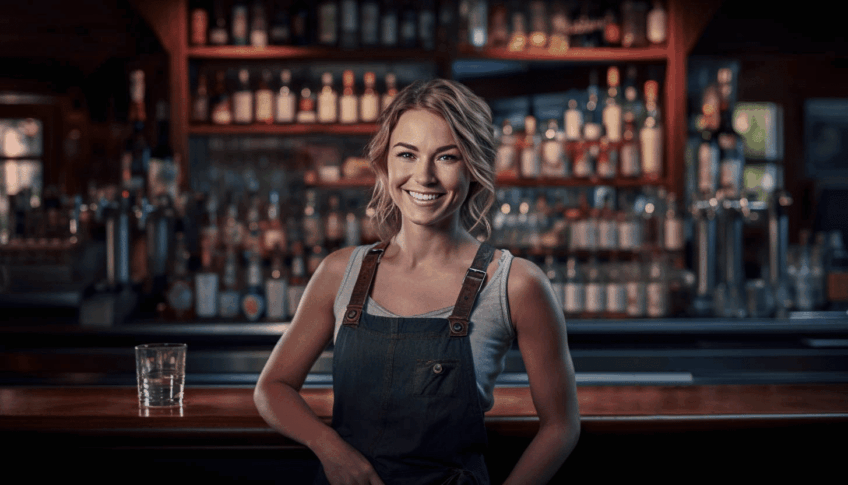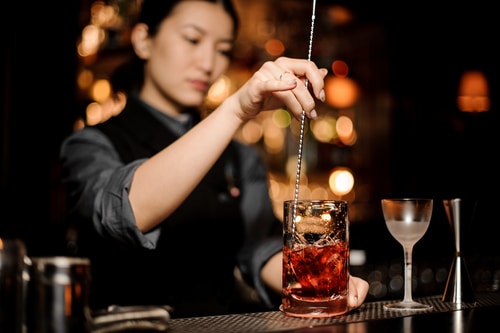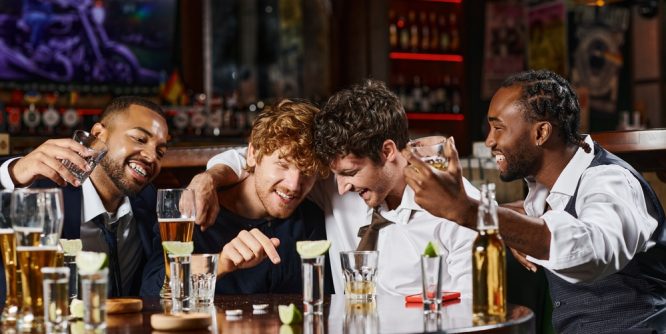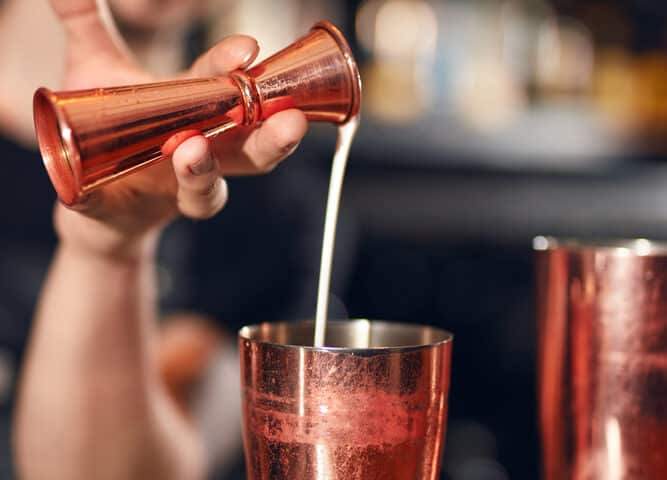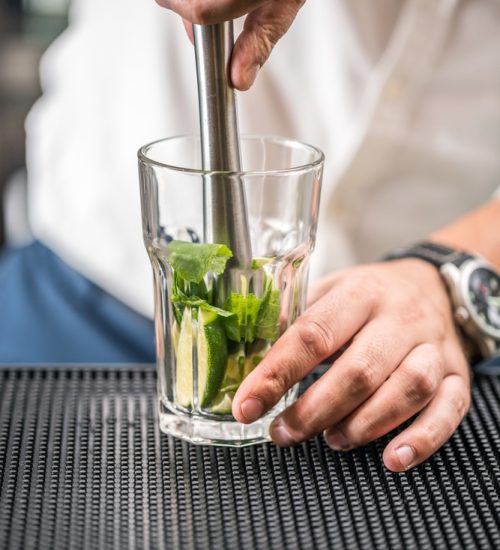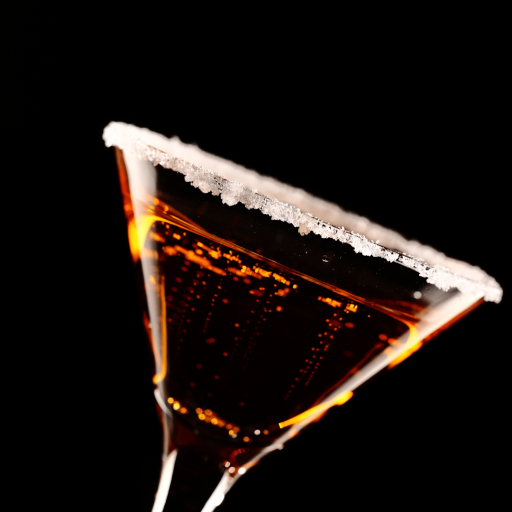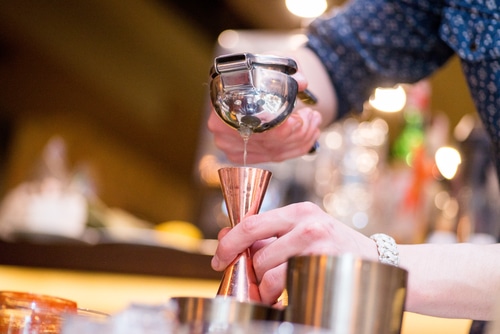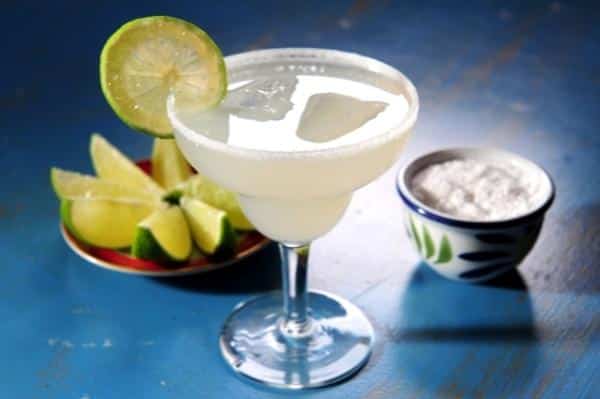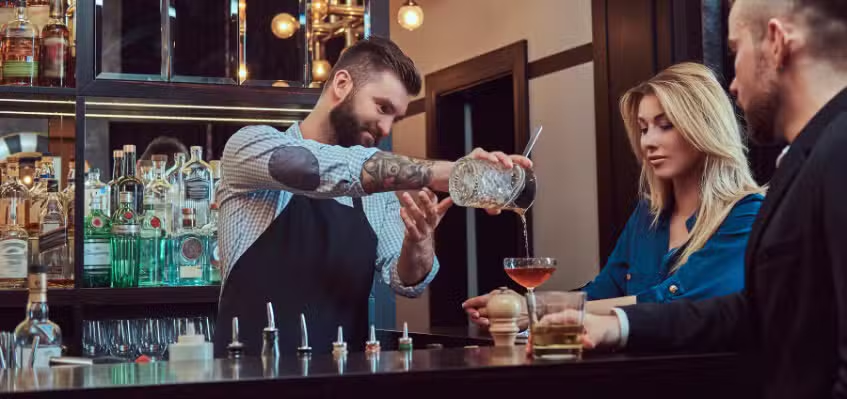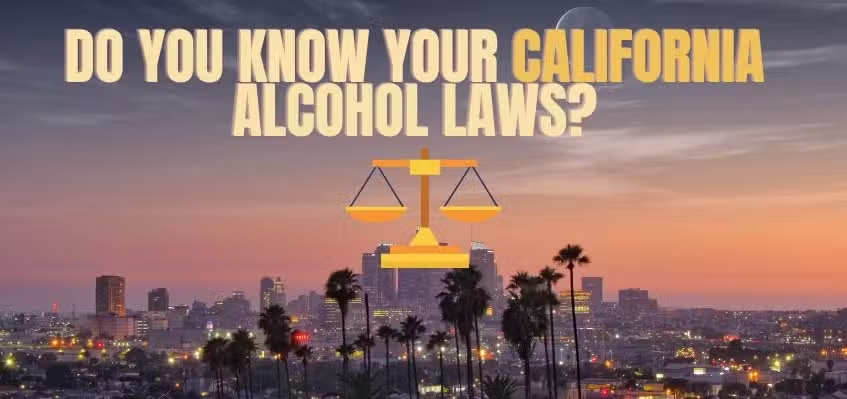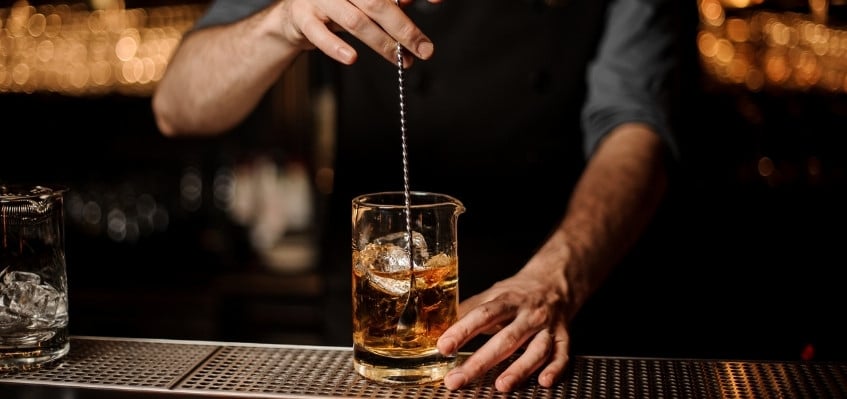Just like any other business, bartenders have their own bartending terminology or bartender lingo. These words will come up during regular operations. Knowing these terms before starting the job is essential. Asking for their definition will slow down the training process and could keep you from earning more tips. Here is a list of bartender terms to get started!
A
Adult – A person of legal drinking age (at least 21).
B
Back – A ‘back’ is a small glass of something (like water or cola) accompanying a drink, e.g., “Scotch on the rocks with a water back.”
Back bar – The area that holds the liquor behind the bar.
Bar back – A bartender’s assistant who does not serve drinks.
Bar Spoon – A long mixing spoon often has a lemon zester or something similar on the other end.
Bitters – An herbal alcoholic blend meant to be added to other cocktails to enhance flavor (e.g., a Manhattan is rye, sweet vermouth, and a couple of dashes of bitters). Angostura Bitters is one of the most popular brands and was first invented by a German physician for stomach disorders in 1824.
Blend – Mix up ingredients and ice in an electric blender. Depending on where you live, these could be called frozen drinks or blended drinks.
Blood alcohol content – (BAC) is the concentration of alcohol in a person’s blood; commonly used as a measurement of intoxication level.
Build – A term to make a drink – starting with ice and then ‘building’ the drink by adding the other ingredients (i.e., alcohol, juice, garnish, etc.).
Burnt – Some recipes call for 1:2 scotch to gin. Others are a drop of peaty single malt swirled around the glass and dumped out. A burnt martini is not a martini, as it contains no vermouth.
C
Call Drink – Refers to when the customer orders a drink by giving the specific name of the liquor and the mixer’s name, e.g., Tanqueray Ten and Tonic, Bacardi, and Coke.
Chaser – A beverage usually drunk immediately after drinking a straight shot of liquor.
Cocktail – Any alcoholic beverage that mixes two or more ingredients.
Comps – Management authorized free drinks; complimentary drinks.
D
Draft – Keg beer served on tap.
Dram Shop – In the United States, dram shop or dramshop is a legal term that refers to the liability of a bar, tavern, or other alcohol-serving establishments.
F
Flame – Setting a drink on fire. Sambuca is often lit on fire to heat it before putting it out and drinking it. Another standard method is to use 151-proof rum, which is very flammable. Bad things can happen!
Float – When one alcohol sits on top of another alcohol in a shooter glass. (E.g., a B-52 shooter contains Kahlua, Irish Cream, and Grand Marnier. Kahlua is heavier than Irish Cream and even heavier than Grand Marnier, so each floats on the other. Floating can be done by carefully pouring down the side of the glass or pouring the floated alcohol over an inverted bar spoon, allowing the alcohol to trickle off the spoon in many directions).
Frappes – The combination of different liquors served over crushed ice; usually an after-dinner drink.
Free Pour – To make and mix drinks without using a measuring device like a jigger or measured pour spout. To pour free of a measuring device, usually straight from a bottle with a non-measured pour spout.
Frost – To frost a glass, dip it in water, drain it, and put it in the freezer. Freezing the glass creates a layer of frost around the glass and works exceptionally well for beer mugs.
G
Garnish – A garnish is something added to a drink after the ingredients to enhance the presentation. Common garnishes are lemon slices, lime wedges, cherries, and olives. Some garnishes are purely for looks, and some add to the drink’s flavor.
Gun – Used to measure and pour soda.
H
Hand pump – Used to serve draft beer.
Highball – Any liquor mixed with soda, served in a tall glass (often called a highball).
I
Impaired behavior – A behavior that can include emotional, physical, and physiological fatigue due to illegal and legal drug use. Impaired behavior is not limited to only alcohol impairment.
Intoxication – The state of being affected by over-consumption of alcohol; recognized by droopy eyelids, slurred speech, uncontrolled movement, loud/offensive conduct, and uncontrolled movement.
J
Jigger – A jigger is an hour-glass shaped steel measuring device – where one side measures 1 ounce (30ml) and the other measures 1½ ounces (45ml). However, jiggers come in many different sizes.
K
Keg – One-half barrel that holds approximately 15.5 gallons.
L
Lager – Beer produced with bottom-fermenting yeast; fermented at much colder temperatures than top-fermented beers.
Layer – Layering a shot or drink is done like floating. The heavier alcohol goes on the bottom, and the next, lighter alcohol gets floated on top using a careful pour down the side of the glass or a pour over an inverted spoon.
Light beer – Low-calorie beer, also usually low alcohol content.
Light-struck – Having a skunk-like smell due to light exposure.
Liquor – Alcoholic beverage with a sweet taste made by flavored ingredients and a spirit.
M
Malt liquor – Higher alcohol content than standard beer.
Metabolism: The process of changing energy sources (food, alcohol, etc.) into energy for the body.
Metallic – Over-aged beer.
Minor – In the United States, ‘minor’ refers to someone under 18 but can be used in certain areas to define someone under 21.
Mist – Fill a glass with crushed ice and pour undiluted spirits on top.
Mixer – Mixers are the non-alcoholic ‘mixes’ accompanying alcohol in drinks. Mixers can be water, soda, juice, energy drinks, etc. (i.e., in the drink Rum & Coke, the mixer is Coke).
Muddle – To crush up ingredients with a unique tool called a muddler. Muddling is done for drinks such as the Mojito – where the muddling process extracts essential oils and flavors (from the mint leaves in the case of the Mojito).
Musty – Moldy flavor and aroma due to cork or brew spillage.
N
Neat – This ones important to know in bar terms. If someone asks for a whiskey neat, they ask for a shot straight out of the bottle. Neat means no ice. Of course, that shot must be in a whiskey glass. Whiskey drinkers are picky!
Nightcap – A drink taken at the end of an evening.
Non-alcoholic – A beverage containing less than 0.5 percent alcohol by volume.
P
Par level – Inventory level set to prevent running out of something.
Par stock – The inventory available to bartenders without going to the storeroom.
Perpetual inventory system – A method used in bars so bar managers can know their liquor inventory anytime. To get started:
1. Log each type of liquor carried and all the associated information regarding costs and ordering.
2. Build a spreadsheet or database to store and automatically update and calculate based on input.
Pony – A pony or pony shot is equal to 1 ounce.
Pouring cost – The cost is determined by dividing consumption by sales.
Premium – Premium refers to premium alcohol or top-shelf liquor (e.g., the well or bar rail gin is Beefeater, and the premium is Tanqueray.
Proof – Measures the strength of alcohol, expressed by a number twice the percentage by volume of alcohol.
R
Racking – Siphoning off the liquid from one vessel to another, leaving behind the sediment on the bottom.
Rim – To rim a glass, first wet the rim with a lime, or the lime juice in a rimmer, then gently press the rim of the glass into a saucer of salt (for margaritas and Bloody Marys), celery salt (for Bloody Caesars) or sugar (for specialty coffees and cocktails). Be creative – look for alternatives like a crushed candy cane, flavored salts, or other exotic spices that match well with your drink’s ingredients.
Roll (aka Box) – To roll or box a drink, first, build the drink, then pour it once into and out of a shaker tin. Rolling mixes the drink gently.
S
S.C.A.B – An customer evaluation technique that includes observing one’s Speech, Coordination, Appearance, and Behavior.
Sale – The point at which money is exchanged for a product; in this industry, alcohol.
Sangria – A wine-based cocktail that contains wine, triple sec, orange juice, and fruit. Many variations exist, and some recipes may call for adding a different juice or may not contain triple sec, but the basis of this drink is wine and juice.
Shaker Tin – A shaker tin is usually metal, while the mixing glass is made from glass. Ice and ingredients are first added to the shaker tin to mix cocktails, and then the mixing glass is placed on the top (creating a seal) and shaken.
Shake – Fill a glass with ice, build the ingredients, pour everything into a shaker tin, and shake. Pour everything back into the original glass. Or, if you are an experienced bartender, you can fill the shaker with ice and ingredients in perfect proportions.
Shake and Strain – Put ice and ingredients into a shaker tin, shake, and strain into a glass. They are often used for shooters and martinis.
Shooter – A shooter or shot is a 1-2 ounce serving of either straight liquor (like Tequila) or a mixture of alcohol (like a B-52 Shooter – Irish Cream, Kahlua, and Grand Marnier) that is meant to be drunk (or shot) in one gulp.
Shot – A small amount of liquor, usually one to two ounces.
Sour – The term ‘sour’ refers to the sourness of sour bar mix, bar lime mix, lime bar mix, or margarita mix (all different names for what are essentially the same thing), which are used in many cocktails (such as a Margarita). If someone orders a Vodka Sour, they want vodka and bar lime mix.
Speed Rail – This bar terminology typically means the long stainless steel shelf connected to the front of the sinks and ice well at bartender stations behind the bar. It holds the most commonly ordered liquor, e.g., rum, vodka, gin, whiskey, and possibly other popular liqueurs or mixes.
Straight up – Refers to a drink, like a martini, shaken in a shaker and strained into a glass. In some areas, straight up is used interchangeably with ‘neat.’
Strain – To drain the liquid out of a shaker tin.
T
Table touch – A monitoring technique when a server or manager visits a guest table to remove unused glassware and asks, “How are you doing?“
Toddy – A sweetened drink of liquor and hot water, often with spices, and served in a tall glass.
Top-shelf – Liquor that is the most expensive.
Tot – Liquor in small amounts.
Twist – The rind of a lemon that is peeled using a special peeler called a zester or lemon zester. The resulting lemon twist is thin and long.
U
Underage – A person under the legal drinking age.
V
Verbal judo – A technique used to reduce and redirect negative behavior using words as a verbal force.
Virgin – Refers to a non-alcoholic drink. They are used to order standard cocktails minus the alcohol, e.g., Virgin Bloody Mary, Virgin Pina Colada.
Are you looking for more information? Check our Behind the Bar Rail, Breaking Down, and Dramshop series. Or enroll in our Master Bartender or Responsible Alcohol Manager course to apply these terms to real-world practice.


